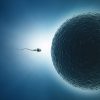
AsianScientist (Jul. 22, 2019) – Scientists may have narrowed down the answer to why women generally outlive men. It comes down to a fundamental difference: sperm and eggs. Researchers from Osaka University, Japan, have led a new study published in Science Advances, showing for the first time that germ cells, which develop into sperm or eggs, have sex-dependent influences in the growth and lifespan of male and female turquoise killifish.
Biologists have had a hunch that reproduction comes at a cost of an organism’s growth and longevity. Life history theory, an idea in evolutionary biology, suggests that when animals allocate their finite resources into having babies, they take away from other processes like health and body maintenance. Similarly, the disposable soma theory states that organisms prioritize reproduction over their own body’s upkeep, as passing on genes is evolutionarily more important than individual longevity.
Some studies have supported this trade-off idea. For instance, removing the germ cells from tiny worms (Caenorhabditis elegans) boosted their growth and lifespan, suggesting that molecular signaling from these cells regulates longevity.
However, when it comes to vertebrates, scientists have been unsure how removing germ cells affects their growth and aging. This uncertainty is partly because vertebrates tend to live longer, making such studies particularly challenging.
To get around this, a research team led by Tohru Ishitani, a professor at the Department of Homeostatic Regulation at Osaka University, chose to study turquoise killifish. This small, freshwater species survives from one to five months, with females typically living longer than males.
The team described that eliminating germ cell production closed the gap between the lifespans of the male and female fish. Without eggs, female killifish experienced a dip in estrogen signaling and a rise in growth factor signaling, which shortened their lifespan by the increase in cardiovascular disease risk.
Conversely, male killifish without sperm showed improved muscle, skin and bone health. They also produced more of a chemical that activates vitamin D, leading to heightened vitamin D signaling in these tissues. Vitamin D functions as a hormone that helps maintain strong bones. The researchers wanted to validate whether it played a role in regulating longevity in all the killifish.
“When we administered active vitamin D, we found that the lifespans of both males and females were significantly extended, suggesting that vitamin D signaling provides health benefits throughout the body,” explains senior author, Tohru Ishitani. “Our work suggests that vitamin D signaling could influence the longevity of other vertebrates, including humans.”
The study reveals an important clue about the complex relationship between reproduction, aging and longevity. Although the precise mechanism of vitamin D in this equation is still unclear, exploring it further could be helpful in developing strategies to extend healthy lifespans.
“The ageing process in killifish is similar to that in humans, so I don’t think humans are necessarily more complicated,” Ishitani said. “I think this research will be a stepping stone to understanding the control of aging in humans.”
—
Source: Osaka University ; Image: Shutterstock
The article can be found at Sex-dependent regulation of vertebrate somatic growth and aging by germ cells.
Disclaimer: This article does not necessarily reflect the views of AsianScientist or its staff.

